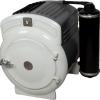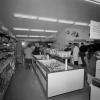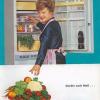Cool and collective
First cooperative freezer in the Alblasserwaard
First cooperative freezer in the Alblasserwaard, by Polygoon-Profilti (producer) / Netherlands Institute for Sound and Vision (curator), is licensed under Creative Commons - Attribution-Share Alike.
The growth of suburban housing, particularly in Northwestern Europe, meant new kitchens and new space for appliances like washing machines and refrigerators. Such spaces were certainly not available to everyone, however.
Despite their symbolic value, refrigerators remained quite expensive, even if they could be purchased in installments. Generally speaking, refrigerators were one of the last luxury appliances that a household acquired, after a vacuum cleaner, washing machine, and television. One key solution was collective refrigeration.
Like collective kitchens in workers' houses, or indeed the collective ovens that were also common in many communities, collective refrigerators and freezers were a solution to the twin problems of space and money. In the Dutch Alblasserwaard, for example, freezer units could be rented for 60 guilders per year.
For these rural women, shown in a newsreel producing much of their own food rather than shopping for it, the availability of freezer units meant new preserving skills rather than shopping skills. Short cooking times for fruit to preserve the vitamins, and then sealing airtight in newly-available plastics – using their household iron! – were the way of the future.
 Previous Story
Next Story
Previous Story
Next Story
How to cite this page
Alexander Badenoch, 'Cool and collective', Inventing Europe, http://www.inventingeurope.eu/daily-lives/cool-and-collective
Sources
- Hård, Mikael and Oldenziel, Ruth. Crafting Europe from Below: Consumers, Tinkerers, Countercultures. Basingstoke: Palgrave, forthcoming



















